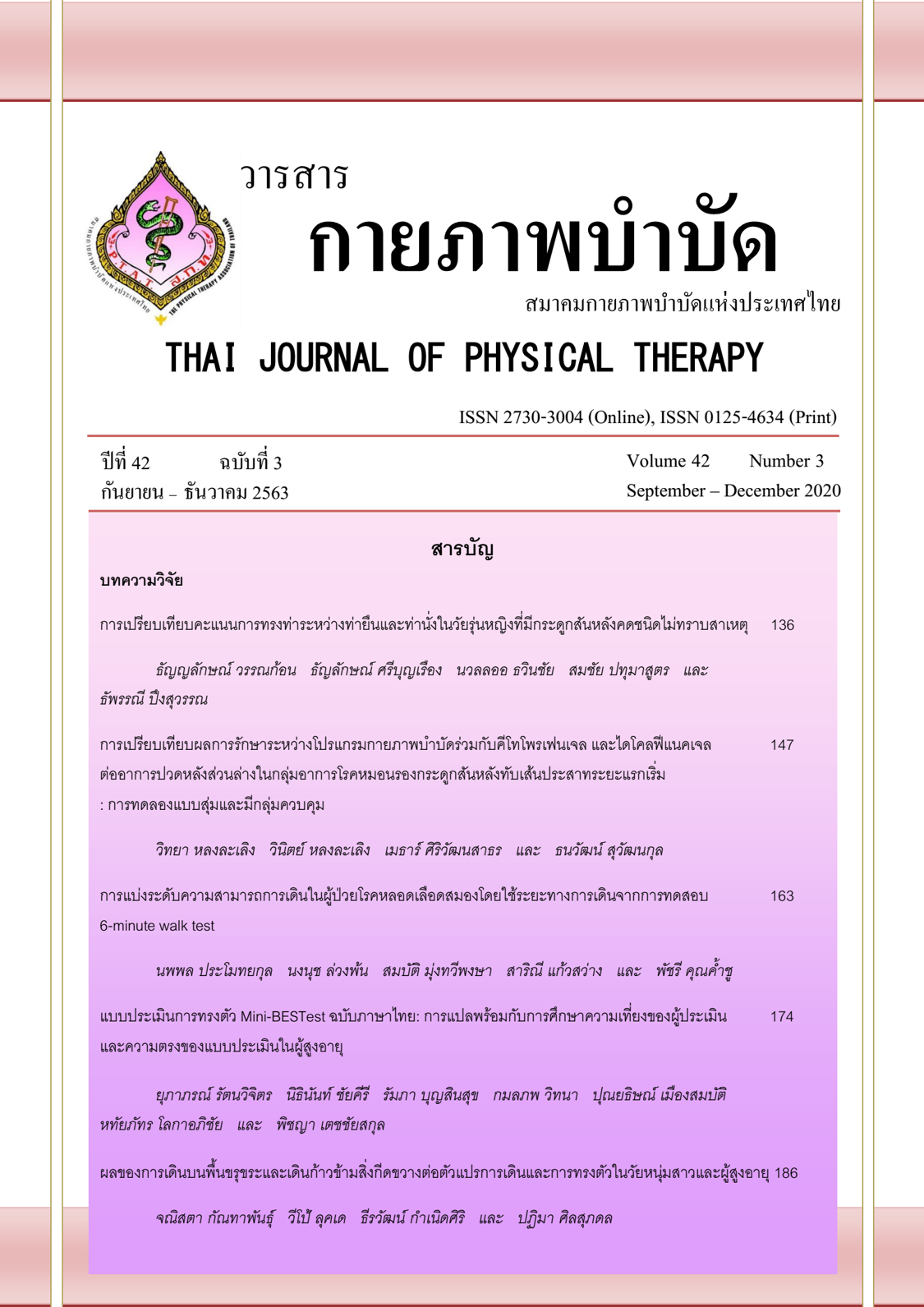Classification of walking ability in patients with stroke by walking distance from 6-minute walk test
Main Article Content
Abstract
Background: The ability to walk, especially walking in the community, is a major factor that encourages individuals with stroke to have a higher level of social participation. Therefore, the assessment to classify the level of walking ability in the community for patients with stroke is important. The walking distance obtained from the 6-minute walk test is one of the interesting variables used for dividing walking ability levels in patients with stroke.
Objective: To investigate a cut-off point of the 6-minute walk test that is appropriate for classifying walking ability in individuals with stroke.
Methods: One hundred seventy-four patients with chronic stroke were recruited into the study. All of the participants were assessed walking ability with Functional walking category and 6-minute walk test. The cut-off point was determined by the Receiver-operating characteristic (ROC) curve.
Results: The results of the study demonstrated that the cut-off point of walking distance in the patients with stroke who can walk in the community was 193.50 meters (sensitivity = 70.00%, and specificity = 94.35%).
Conclusion: This study found that patients with stroke who can walk at least 193.50 meters in 6 minutes will be able to walk in the community.
Article Details
References
Bijleveld-Uitman M, van de Port I, Kwakkel G. Is gait speed or walking distance a better predictor for community walking after stroke? J Rehabil Med. 2013;45:535-40.
Wandel A, Jorgensen HS, Nakayama H, Raaschou HO, Olsen TS. Prediction of walking function in stroke patients with initial lower extremity paralysis: the Copenhagen Stroke Study. Arch Phys Med Rehabil. 2000;81:736-8.
Barclay R, Ripat J, Mayo N. Factors describing community ambulation after stroke: a mixed-methods study. Clin Rehabil. 2015;29:509-21.
Lord SE, McPherson K, McNaughton HK, Rochester L, Weatherall M. Community ambulation after stroke: how important and obtainable is it and what measures appear predictive? Arch Phys Med Rehabil. 2004;85:234-9.
Lee KB, Lim SH, Ko EH, Kim YS, Lee KS, Hwang BY. Factors related to community ambulation in patients with chronic stroke. Top Stroke Rehabil. 2015;22:63-71.
Salbach NM, O'Brien K, Brooks D, Irvin E, Martino R, Takhar P, et al. Speed and distance requirements for community ambulation: a systematic review. Arch Phys Med Rehabil. 2014;95:117-28 e11.
Perry J, Garrett M, Gronley JK, Mulroy SJ. Classification of walking handicap in the stroke population. Stroke. 1995;26:982-9.
van de Port IG, Kwakkel G, Lindeman E. Community ambulation in patients with chronic stroke: how is it related to gait speed? J Rehabil Med. 2008;40:23-7.
Dobkin BH. Short-distance walking speed and timed walking distance: redundant measures for clinical trials? Neurology. 2006;66:584-6.
Kollen B, Kwakkel G, Lindeman E. Hemiplegic gait after stroke: is measurement of maximum speed required? Arch Phys Med Rehabil. 2006;87:358-63.
Salbach NM, Mayo NE, Higgins J, Ahmed S, Finch LE, Richards CL. Responsiveness and predictability of gait speed and other disability measures in acute stroke. Arch Phys Med Rehabil. 2001;82:1204-12.
Schmid A, Duncan PW, Studenski S, Lai SM, Richards L, Perera S, et al. Improvements in speed-based gait classifications are meaningful. Stroke. 2007;38:2096-100.
Lord SE, Rochester L. Measurement of community ambulation after stroke: current status and future developments. Stroke. 2005;36:1457-61.
Eng JJ, Dawson AS, Chu KS. Submaximal exercise in persons with stroke: test-retest reliability and concurrent validity with maximal oxygen consumption. Arch Phys Med Rehabil. 2004;85:113-8.
Joa KL, Kwon SY, Choi JW, Hong SE, Kim CH, Jung HY. Classification of walking ability of household walkers versus community walkers based on K-BBS, gait velocity and upright motor control. Eur J Phys Rehabil Med. 2015;51:619-25.
Dunn A, Marsden DL, Nugent E, Van Vliet P, Spratt NJ, Attia J, et al. Protocol variations and six-minute walk test performance in stroke survivors: a systematic review with meta-analysis. Stroke Res Treat. 2015;2015:484813.
Hoffer MM, Feiwell E, Perry R, Perry J, Bonnett C. Functional ambulation in patients with myelomeningocele. J Bone Joint Surg Am. 1973;55:137-48.
Combs SA, Van Puymbroeck M, Altenburger PA, Miller KK, Dierks TA, Schmid AA. Is walking faster or walking farther more important to persons with chronic stroke? Disabil Rehabil. 2013;35:860-7.
Hajian-Tilaki K. Receiver Operating Characteristic (ROC) Curve Analysis for Medical Diagnostic Test Evaluation. Caspian J Intern Med. 2013;4:627-35.
Portney L, Watkins M. Foundation of clinical research: Applications to practice 3ed. New Jersy: Pearson Prentice Hall; 2009.
An S, Lee Y, Shin H, Lee G. Gait velocity and walking distance to predict community walking after stroke. Nurs Health Sci. 2015;17:533-8.
Fulk GD, He Y, Boyne P, Dunning K. Predicting Home and Community Walking Activity Poststroke. Stroke. 2017;48:406-11.
Tudor-Locke C, Bassett DR, Jr. How many steps/day are enough? Preliminary pedometer indices for public health. Sports Med. 2004;34:1-8.
Robinett CS, Vondran MA. Functional ambulation velocity and distance requirements in rural and urban communities. A clinical report. Phys Ther. 1988;68:1371-3.
Danielsson A, Willen C, Sunnerhagen KS. Is walking endurance associated with activity and participation late after stroke? Disabil Rehabil. 2011;33:2053-7.
Van Dyck D, Deforche B, Cardon G, De Bourdeaudhuij I. Neighbourhood walkability and its particular importance for adults with a preference for passive transport. Health Place. 2009;15:496-504.

